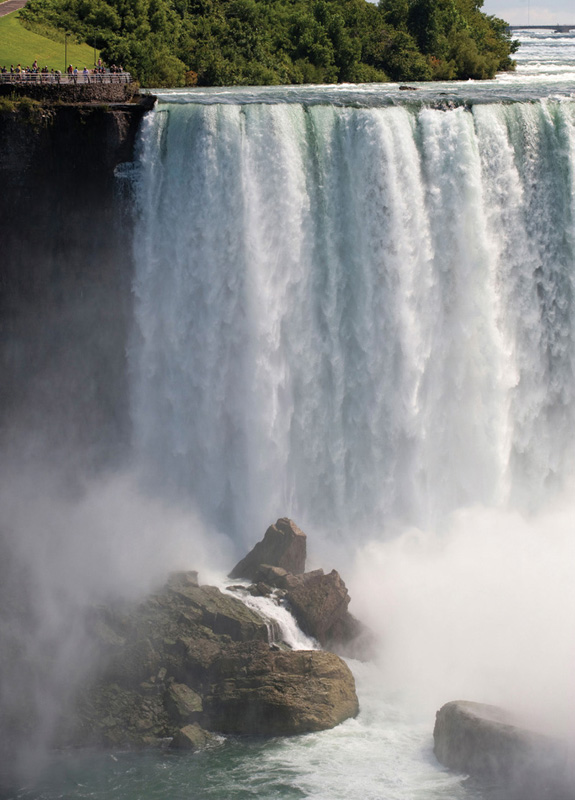83 Go over Niagara Falls in a barrel
WHAT IT IS An act of derring-do at the world’s most famous waterfalls
WHY YOU WON’T DO IT There’s a big risk that they’ll be scraping the bottom of the barrel once they find your remains
One of the world’s great sites of natural beauty, you can view Niagara Falls from any number of comfortable spots. Alternatively, you can take the famous Maid of the Mist cruise at the foot of the falls, or even fly over them in a helicopter. Not floating your boat? Well, if you want a really intimate view there is another alternative …
Niagara Falls sit on the border between Canada and New York State, and actually consists of three separate falls: the Horseshoe Falls on the Canadian side and the smaller American Falls and Bridal Veil Falls on the New York side. The most impressive are the Horseshoe Falls, some 790 metres (2,600 ft) wide, and with a drop of 53 metres (173 ft) into the wild and freezing waters. Some 2.27 million litres (600,000 gallons) pour through each second, having come via four of the five Great Lakes.
The first person to come up with the idea of going over the Falls in a barrel was a retired schoolteacher by the name of Annie Edson Taylor, who decided to celebrate her 63rd birthday in this unusual style. Rather unfairly, she decided to test her specially adapted pickle barrel before use with her cat Iagara. The unwilling feline guinea-pig survived with only a small cut to the head, and the redoubtable Ms Taylor followed two days later on 24 October 1901. She survived 40 minutes in the barrel, emerging with a cut forehead to match that of her cat, and lived on for another two decades, eventually being laid to rest in the ‘stunters’ section’ of nearby Oakwood Cemetery. So how might you follow in her wake?
Firstly, consider your motivation. Do you have a death wish? If so, get professional help or lie down in a darkened room until the feeling passes. Aside from deliberate suicides, 15 others have purposely hurled themselves over the Falls since Annie Taylor, in a variety of more or less robust vessels. Many of them were apparently motivated by the promise of fame and fortune, and five of them have died in the process, but how many of them can you name?
These days, it’s a criminal offence to go ‘stunting without a licence’ at the Falls, carrying a fine of up to CA$10,000. The authorities have shown little sympathy to impromptu daredevils over the years – for instance, in 2003 a gent by the name of Kirk Jones went over without a barrel and survived, even turning down a lift back to shore from the Maid of the Mist. He was fined CA$2,300 for his efforts, and banned from ever entering Canada again, whether via waterfall or other means.
FALLING HERO William ‘Red’ Hill, the self-proclaimed ‘Master Hero of Niagara’, prepares to navigate the falls for a third time in 1931. Hill rose to fame after saving the life of another Niagara stunter, Bobby Leach, in 1910, and is credited with saving some 28 people from drowning in and around the falls.
So what of the physical risks? The barrels used have all been robust and specially strengthened for the job, but regardless of how much padding is put inside, you’ll still get buffeted about, leading to risks of broken bones, cuts, bruises and concussion, not to mention being dashed on rocks. This is one reason why all the successful descents have gone over the Horseshoe Falls – they are relatively boulder-free compared to the rockier American Falls.
If you come through the actual descent, you still have to contend with the threat of drowning in ice-cold water – Annie Taylor was only retrieved some 20 minutes after her plunge, and reportedly found the wait for rescue the most terrifying part of her ordeal. Some of the barrel-rollers have fitted straps inside their barrels to give them increased stability, and many have also added ballast (often, bizarrely, in the form of anvils) to ensure they go over feet first. These precautions backfired fatally for Englishman Charles Stephens, who in 1920 became the first person to die in an attempt. On hitting the water, the anvil that he had tied to his feet went through the base of the barrel, taking the ill-fated Stephens with it. When the barrel was retrieved, a rather gruesome discovery was made – Stephens’s right arm was still strapped to the interior.
There are several theories as to why certain attempts succeed. Some say it’s about going into the water quite close to the lip of the Falls, so you don’t build up excessive speed on the run in. Others posit that there are ‘water cones’ offering soft landing zones at the base of the Falls, though whether you encounter these seems more a matter of luck than judgement. Another theory suggests that those who succeed effectively ‘ride’ the water, much like a surfer rides a wave. Except, of course, they’re doing it on vertical water, as it were. Quite how you can knowingly ‘ride’ while crammed into a barrel is a further question that has not yet been adequately explored.
NIAGARA An imposing view of the falls.

